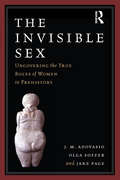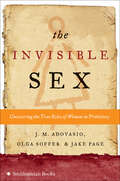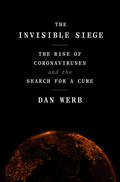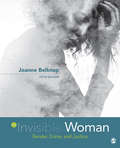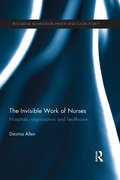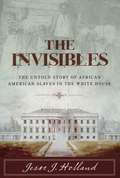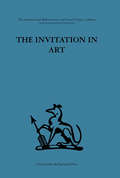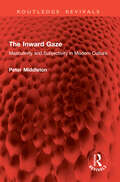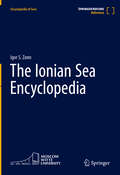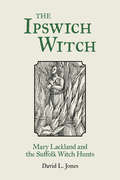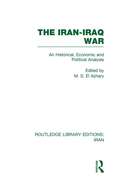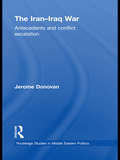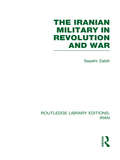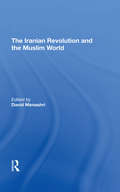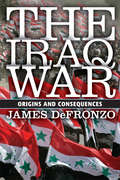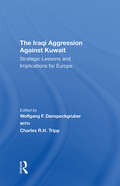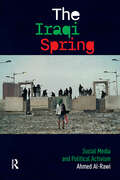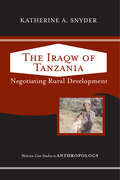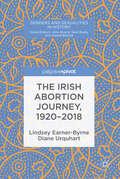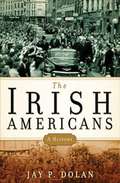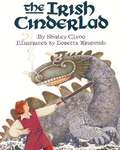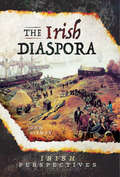- Table View
- List View
The Invisible Sex: Uncovering the True Roles of Women in Prehistory
by Jake Page Olga Soffer J. M. AdovasioShaped by cartoons and museum dioramas, our vision of Paleolithic times tends to feature fur-clad male hunters fearlessly attacking mammoths while timid women hover fearfully behind a boulder. Recent archaeological research has shown that this vision bears little relation to reality. J. M. Adovasio and Olga Soffer, two of the world's leading experts on perishable artifacts such as basketry, cordage, and weaving, present an exciting new look at prehistory. With science writer Jake Page, they argue that women invented all kinds of critical materials, including the clothing necessary for life in colder climates, the ropes used to make rafts that enabled long-distance travel by water, and nets used for communal hunting. Even more important, women played a central role in the development of language and social life—in short, in our becoming human. In this eye-opening book, a new story about women in prehistory emerges with provocative implications for our assumptions about gender today.
The Invisible Sex: Uncovering the True Roles of Women in Prehistory
by Jake Page Olga Soffer J. M. Adovasio“This jauntily written, highly convincing analysis . . . argues that women of prehistory were pivotal in a wide range of culture-building endeavors.” —Publishers WeeklyShaped by cartoons and museum dioramas, our vision of Paleolithic times tends to feature fur-clad male hunters fearlessly attacking mammoths while timid women hover fearfully behind a boulder. In fact, recent research has shown that this vision bears little relation to reality.The field of archaeology has changed dramatically in the past two decades, as women have challenged their male colleagues' exclusive focus on hard artifacts such as spear points rather than tougher to find evidence of women's work. J. M. Adovasio and Olga Soffer are two of the world's leading experts on perishable artifacts such as basketry, cordage, and weaving. In The Invisible Sex, the authors present an exciting new look at prehistory, arguing that women invented all kinds of critical materials, including the clothing necessary for life in colder climates, the ropes used to make rafts that enabled long-distance travel by water, and nets used for communal hunting. Even more important, women played a central role in the development of language and social life—in short, in our becoming human. In this eye-opening book, a new story about women in prehistory emerges with provocative implications for our assumptions about gender today.“An engaging book that sets the record straight while describing current theories and trends in archaeology.” —Booklist“A much-needed antidote to the past hundred years of popular and scientific writing on prehistoric human life.” —Nature“Science writing at its best.” —Jean M. Auel, #1 New York Times–bestselling author of Clan of the Cave Bear
The Invisible Siege: The Rise of Coronaviruses and the Search for a Cure
by Dan Werb&“A journey into the origins of COVID-19 and the discovery of vaccines and potential cures . . . I learned so much that I didn&’t know before—above all, I met the subtle warriors of the laboratory who are working to save all of us from the horror of new pandemics.&”—Richard Preston, bestselling author of The Hot Zone and The Demon in the Freezer One of Publishers Weekly&’s top ten science books of the season The urgency of the devastating COVID-19 pandemic has fixed humanity&’s gaze on the present crisis. But the story of this pandemic extends far further back than many realize. In this engrossing narrative, epidemiologist Dan Werb traces the rising threat of the coronavirus family and the attempts by a small group of scientists who worked for decades to stop a looming viral pandemic.When virologist Ralph Baric began researching coronaviruses in the 1980s, the field was a scientific backwater—the few variants that infected humans caused little more than the common cold. But when a novel coronavirus sparked the 2003 SARS epidemic, and then the MERS epidemic a decade later, Baric and his allies realized that time was running out before a pandemic strain would make the inevitable jump from animals to human hosts.In The Invisible Siege, Werb unpacks the dynamic history and microscopic complexity of an organism that has wreaked cycles of havoc upon the world for millennia. Elegantly tracing decades of scientific investigation, Werb&’s book reveals how Baric&’s team of scientists hatched an audacious plan not merely to battle COVID-19 but to end pandemics forever. Yet as they raced to find a cure, they ran into a complicated nexus of science, ethics, industry, and politics that threatened to derail their efforts just as COVID-19 loomed ever larger.The Invisible Siege is an urgent and moving testament to the unprecedented scientific movement to stop COVID-19—and a powerful look at the infuriating factors that threaten to derail discovery and leave the world vulnerable to the inevitable coronaviruses to come.
The Invisible Woman: Gender, Crime, and Justice
by Joanne E. BelknapThe Invisible Woman: Gender, Crime, and Justice offers a thorough exploration of the theories and issues regarding the experiences of women and girls with the criminal justice system as victims, offenders, and criminal justice professionals. Working to counter the "invisibility" of women in criminal justice, this definitive text utilizes a feminist perspective that incorporates current research, theory, and the intersections of sexism with racism, classism, and other types of oppression. Focusing on empowerment of marginalized populations, author Joanne Belknap&’s gendered approach to the criminal justice system examines how to improve the visibility of women and to promote their role in society.
The Invisible Woman: Gender, Crime, and Justice
by Joanne E. BelknapThe Invisible Woman: Gender, Crime, and Justice offers a thorough exploration of the theories and issues regarding the experiences of women and girls with the criminal justice system as victims, offenders, and criminal justice professionals. Working to counter the "invisibility" of women in criminal justice, this definitive text utilizes a feminist perspective that incorporates current research, theory, and the intersections of sexism with racism, classism, and other types of oppression. Focusing on empowerment of marginalized populations, author Joanne Belknap&’s gendered approach to the criminal justice system examines how to improve the visibility of women and to promote their role in society.
The Invisible Work of Nurses: Hospitals, Organisation and Healthcare
by Davina AllenNursing is typically understood, and understands itself, as a care-giving occupation. It is through its relationships with patients – whether these are absent, present, good, bad or indifferent – that modern day nursing is defined. Yet nursing work extends far beyond direct patient care activities. Across the spectrum of locales in which they are employed, nurses, in numerous ways, support and sustain the delivery and organisation of health services. In recent history, however, this wider work has generally been regarded as at best an adjunct to the core nursing function, and at worse responsible for taking nurses away from their ‘real work’ with patients. Beyond its identity as the ‘other’ to care-giving, little is known about this element of nursing practice. Drawing on extensive observational research of the everyday work in a UK hospital, and insights from practice-based approaches and actor network theory, the aim of this book is to lay the empirical and theoretical foundations for a reappraisal of the nursing contribution to society by shining a light on this invisible aspect of nurses’ work. Nurses, it is argued, can be understood as focal actors in health systems and through myriad processes of ‘translational mobilisation’ sustain the networks through which care is organised. Not only is this work an essential driver of action, it also operates as a powerful countervailing force to the centrifugal tendencies inherent in healthcare organisations which, for all their gloss of order and rationality, are in reality very loose arrangements. The Invisible Work of Nurses will be interest to academics and students across a number of fields, including nursing, medical sociology, organisational studies, health management, science and technology studies, and improvement science.
The Invisibles: The Untold Story of African American Slaves in the White House
by Jesse J. HollandTHE INVISIBLES: Slavery Inside The White House and How It Helped Shape America is the first book to tell the story of the executive mansion's most unexpected residents, the African American slaves who lived with the U. S. presidents who owned them. Interest in African Americans and the White House are at an all-time high due to the historic presidency of Barack Obama, and the soon-to-be-opened Smithsonian National Museum of African American Culture and History. The Invisibles chronicles the African American presence inside the White House from its beginnings in 1782 until 1862, when President Abraham Lincoln issued the Emancipation Proclamation that granted slaves their freedom. During these years, slaves were the only African Americans to whom the most powerful men in the United States were exposed on a daily, and familiar, basis. By reading about these often-intimate relationships, readers will better understand some of the views that various presidents held about class and race in American society, and how these slaves contributed not only to the life and comforts of the presidents they served, but to America as a whole. "
The Invitation in Art
by Adrian StokesTavistock Press was established as a co-operative venture between the Tavistock Institute and Routledge & Kegan Paul (RKP) in the 1950s to produce a series of major contributions across the social sciences. This volume is part of a 2001 reissue of a selection of those important works which have since gone out of print, or are difficult to locate. Published by Routledge, 112 volumes in total are being brought together under the name The International Behavioural and Social Sciences Library: Classics from the Tavistock Press. Reproduced here in facsimile, this volume was originally published in 1965 and is available individually. The collection is also available in a number of themed mini-sets of between 5 and 13 volumes, or as a complete collection.
The Inward Gaze: Masculinity and Subjectivity in Modern Culture (Routledge Revivals)
by Peter MiddletonFirst published in 1992, The Inward Gaze looks at men’s fantasies and self-images from a wide range of texts (notably boy’s superhero comics, modernist literary classics, and a Freudian case-study) to discuss the theories of subjectivity, masculinity, and emotion.The author explores the split between the experience-based claims of the men’s movement and the discourse theories of postmodernism. Does this division reveal a continuing refusal of masculine self-awareness? Why does postmodernist theory investigate desire and ignore emotion?This is a ground-breaking and controversial book which seeks to reformulate the way we think about men’s subjectivity. Its interdisciplinary approach weaves together material from many different sources and will be of vital interest to students of literature, cultural studies, gender studies, and psychoanalysis.
The Ionian Sea Encyclopedia (Encyclopedia of Seas)
by Igor S. ZonnThe book is dedicated to the Ionian Sea, which is part of the Mediterranean. The encyclopedia contains about 600 articles on the hydrographic and geographic objects, hydrological features of the sea, biological resources, as well as administrative-territorial units of the Ionian countries. The most significant natural objects like islands, peninsulas, bays, rivers, mountains, their geographical peculiarities are briefly described as well as economy, culture and history, cities, ports, international agreements, research institutions, activities of outstanding scientists, researchers, travelers are presented in the publication. The chronology of the main historical events that have become significant landmarks in the history of discovery and exploration of the Ionian Sea from the 31 B.C. to the present day is given.
The Ipswich Witch: Mary Lackland and the Suffolk Witch Hunts
by David L. JonesAgainst the backdrop of the largest witch hunt in English history, this book is both an investigation of a miscarriage of justice 366 years old and an in-depth recreation of East Anglia as it once was. Ipswich, faced by the extreme challenges of war, religious dissent, poverty, sickness and the threat of foreign invasion, became an ideological battlefield during the civil wars. As Puritanism struggled against Catholic sensibilities, the Devil himself loomed at the door of every English home, and the age of the witchfinder was born. This book aims to challenge some of our stereotypes of the period, and to show how witch hunts do not stand apart from history but reflect the growth in Puritan sects, gender politics, the exploitation of the poor, the importance of popular beliefs in the occult and the rise of English power in the New world. Written by David L. Jones of the Ipswich Museum, and inspired by his time living in rural Nepal, where witchcraft is considered an everyday reality, it will fascinate visitors and residents alike.
The Iran-Iraq War: An Historical, Economic And Political Analysis (Routledge Library Editions: Iran)
by M. S. EL-AzharyThe Iran-Iraq war broke out in September 1980. It brought death and suffering to hundreds of thousands of people on both sides and devastated the economies of both countries. It also increased international tensions by precipitating new alliances and rearrangement of forces in the already turbulent Middle East. The focus of this book is on the historical, economic and political dimensions of the war between Iraq and Iran. It examines many aspects of what proved to be a very complex conflict; including its long history, its present economic and political setting, the different responses to the war by outside parties and its regional and world implications.
The Iran-Iraq War: Antecedents and Conflict Escalation (Routledge Studies in Middle Eastern Politics)
by Jerome DonovanIn a tradition that dates back to the time of Thucydides, and the Peloponnesian War, the systematic examination of conflict and war has long been a preoccupation of political scientists seeking to resolve the enduring question: Why do wars occur? This study directly engages this question with a specific focus on explaining the conflict between Iran and Iraq, arguably the longest and one of the more costly conventional wars of the twentieth century. Explaining the systemic nature of conflict within the Middle East, and specifically between Iran and Iraq, the book illustrates how IR theory can be utilised in explaining conflict dynamics in the Middle East. The author’s integrated approach to understanding interstate conflict escalation demonstrates that when taken together issues, interaction and power capabilities lend themselves to a much richer account of the dyadic relationship between Iran and Iraq in the lead up to war in 1980. Addressing a disparity between international relations and Middle Eastern area studies, this book fills an important gap in the existing scholarly literature on the causes of war. As such, it will be of great interest to scholars of peace and conflict studies, Middle Eastern studies and International Relations.
The Iranian Military in Revolution and War (Routledge Library Editions: Iran)
by Sepehr ZabirThis book is a fascinating critical examination of the characteristics and development of the armed forces in Iran, their role under the Shah and their re-creation in the war against Iraq as the fighting forces of Islam. The author examines the contradictory accounts, including the Shah’s own Answer to History, as well as newly available accounts by highly placed ex-officials, and interviews with exiled army officers. He examines in detail the apparent shift of allegiance within the forces from the Shah to Imam and the ways in which this was accomplished. Major Iranian offensives, changing strategies from human wave assault to the Tankers War, and the delicate balance between the regular Army and the Revolutionary Guards, are also extensively examined. The book concludes with an analysis of the potential role of the armed forces in a succession crisis.
The Iranian Revolution And The Muslim World
by David MenashriThis book delineates the Islamic revolution's impact mainly on the Muslim Middle East and examines the first decade of the revolution. It deals with the repercussions of the revolution in several Shi'i communities and examines Sunni polemical writings on the Shi'a and the Iranian revolution.
The Iraq War: Origins and Consequences
by James DeFronzoThis book explains why the Iraq War took place, and the war's impacts on Iraq, the United States, the Middle East, and other nations around the world. It explores conflict's potential consequences for future rationales for war, foreign policy, the United Nations, and international law and justice.
The Iraqi Aggression Against Kuwait: Strategic Lessons And Implications For Europe
by Charles Tripp Wolfgang F. DanspeckgruberThe war for the liberation of Kuwait following the Iraqi invasion in 1990 rekindled the international community's geopolitical interest in the Gulf and helped define a new regional order. This book analyzes the political, strategic, and economic dimensions of the second Gulf War, with particular focus on military aspects. An international roster of experts treats issues of strategy, weapons technology, arms transfers, and the impact on the Arab state system. Of special interest is the exploration of the implications of the war for Japan, Germany, Russia, and Europe.
The Iraqi Federation: Origin, Operation and Significance (Exeter Studies in Ethno Politics)
by Farah ShakirPolitical instability has characterised the modern history of Iraq, which has proven itself as a complex state to govern. However, the creation of a federal system in 2005 offers the potential for change and a deviation from a past characterised by authoritarian government, brutality and war. The Iraqi Federation explores why and how Iraq became a federal state, and analyses how the process of formation impacts on the operation of the Iraqi federal system. It argues that the different approaches taken by various federal theorists in the past, particularly William H. Riker’s bargain theory, are insufficient to explain the formation of the Iraqi federation completely. The process of the establishment of a federal Iraq must be understood in the context of its unique history and cultural specificity, as well as in the context of the other new federal models that have appeared since the end of the Cold War, including Belgium, the Russian Federation, Ethiopia, Bosnia and Herzegovina and Nigeria. Drawing on interviews with contemporary political players in Iraq, this book helps to deepen our understanding of how one of the newest federal states operates in a practical sense. By linking the new federal models to the classic federal theory, it also provides a unique contribution to theories on federal state formation. It will therefore be of great interest to students and scholars of Middle East Politics, as well as those studying Federalism.
The Iraqi Spring: Social Media and Political Activism
by Ahmed Al-RawiSince 2003 and following the U.S.-led invasion, Iraq witnessed tremendous changes to its political, social, and economic structures, and this book critically maps recent popular protests that engulfed the country and led to the death of thousands of civilian protesters. It delves into the nuances of the Iraqi socio-political context and offers a brief historical overview of political activism by investigating the internal structure of activism in the country as well as the regional and international dimensions. The study involves critical ethnographic research including interviews with Iraqi activists, social media analysis, Arabic and English news analysis, as well as in-depth assessment and contextualization of the Iraqi protests. The author argues that there is a need to call the protests an “Iraqi Spring” because of the country's unique historical, demographic, and political circumstances.
The Iraqw Of Tanzania: Negotiating Rural Development (Case Studies in Anthropology)
by Katherine SnyderBased on the author's fieldwork, the author considers the rural development of the Iraqw of Tanzania--a little-studied group of mixed pastoralist-agriculturalists. . Author Katherine Snyder focuses on how the Iraqw perceive, respond to, and affect development projects in Tanzania. Snyder explores how the ideology of development affects people's actions, from what crops to plant, to what to wear and do at their weddings, and considers too how issues of development play out between elders and juniors, men and women, and wealthy and poor. She shows the creativity of local actors in adapting to new ideological shifts and using the rhetoric of development to pursue their own goals. Avoiding jargon and making extensive use of vignettes - stories of peoples' lives and incidents - The Iraqw of Tanzania illustrates its themes in a manner useful and fascinating to students. *Detailed, richly textu red ethnographic material Covers fundamental anthropology topics (kinship, politics, gender, economy, etc) A small, affordable case studies book to be assigned with a core textbook in introductory anthropology courses. Africa, Third World development, postcolonial studies, and anthropology of religion.
The Irish Abortion Journey, 1920–2018 (Genders and Sexualities in History)
by Lindsey Earner-Byrne Diane UrquhartThis book reframes the Irish abortion narrative within the history of women’s reproductive health and explores the similarities and differences that shaped the history of abortion within the two states on the island of Ireland. Since the legalisation of abortion in Britain in 1967, an estimated 200,000 women have travelled from Ireland to England for an abortion. However, this abortion trail is at least a century old and began with women migrating to Britain to flee moral intolerance in Ireland towards unmarried mothers and their offspring. This study highlights how attitudes to unmarried motherhood reflected a broader cultural acceptance that morality should trump concerns regarding maternal health. This rationale bled into social and political responses to birth control and abortion and was underpinned by an acknowledgement that in prioritising morality some women would die.
The Irish Americans: A Historical Reader
by James V. MullinKey events and issues in American history through the voices of the Irish Americans who experienced them firsthand.
The Irish Americans: A History
by Jay P. Dolan[from inside flaps] "Jay P. Dolan of the University of Notre Dame is one of America's most acclaimed scholars of immigration and ethnic history. In The Irish Americans, he caps his decades of research and writing with a magisterial history of the Irish experience in the United States. Dolan draws on his own groundbreaking work and much other recent scholarship to create a fresh and vivid narrative. He follows the Irish from their first arrival in the American colonies through the bleak days of the potato famine that brought millions of poor immigrants; the decades of ethnic prejudice and nativist discrimination; the rise of Irish political power and the heyday of Tammany politics; and on to the historic moment when John F. Kennedy was elected to the highest office in the land. Dolan evokes the ghastly ships crowded with men and women fleeing the potato blight; the vibrant life of Catholic parishes in cities like New York and Chicago, where the sound of church bells marked the rhythm of each day; and the world of machine politics, where ward bosses often held court in the local saloon. Rich in colorful detail, balanced in judgment, and the most comprehensive work of its kind yet published, The Irish Americans weaves a captivating tapestry of the Irish American experience."
The Irish Cinderlad
by Shirley ClimoBecan, a poor boy belittled by his stepmother and stepsisters, rescues a princess in distress after meeting a magical bull.
The Irish Diaspora: The 1641 Rebellion In Irish History And Memory (Irish Perspectives)
by John GibneyA history of the Irish migrant experience across the globe, as told through real-life stories from throughout the centuries.Ireland is known worldwide as a country that produced emigrants. The existence of the Irish “diaspora” is the subject of this fifth installment of the Irish Perspectives series. From the early Christian era, Irish missionaries traveled across Europe. From the early modern period, Irish soldiers served across the world in various European armies and empires. And in the modern era, Ireland’s position on the edge of the Atlantic made Irish emigrants amongst the most visible migrants in an era of mass migration. Ranging from Europe to Africa to the Americas and Australia, this anthology explores the lives and experiences of Irish educators, missionaries, soldiers, insurgents, from those who simply sought a better life overseas to those with little choice in the matter, all establishing an Irish presence across the globe as they did so.
